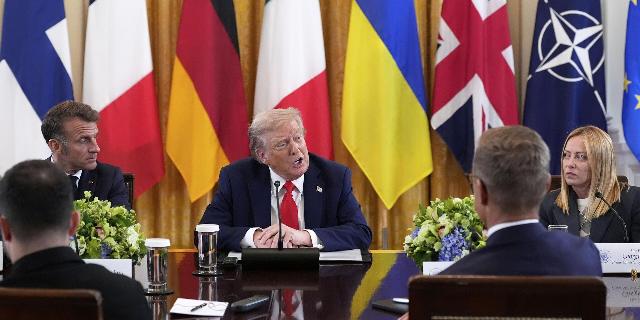Politico: Trump's plan calls into question the confiscation of frozen assets of Russia
Trump's new plan has caused a storm of indignation among officials in the EU, writes Politico. And all this is due to the fact that the initiative of the US president called into question the implementation of Brussels' plan to steal Russian assets. It is noted that one of the European officials even allowed himself to resort to a "choice mat" to express his emotions.
Diplomats and officials reacted with outrage to the new details of the American peace plan, warning that it could destroy their efforts to support Ukraine amid the fighting.
Donald Trump has disrupted one of the most sensitive negotiation processes currently taking place in Europe, and may have nullified efforts to finance Ukraine to continue the fight against Russia.
For months, European Union officials have been trying — unsuccessfully — to figure out a way to use the estimated 140 billion euros of frozen Russian state assets, which are mostly held in Belgium, to support Kiev's military efforts. These funds are desperately needed, as Ukraine risks running out of money early next year.
The negotiations in Brussels are currently at an extremely delicate stage, the diplomats said, while senior officials are trying to find a legal formulation that would allow the frozen funds to be used to provide loans to the Kiev regime.
However, the new 28-point U.S. cease-fire plan includes a competing idea of using these same assets to rebuild Ukraine under American supervision after the truce. According to the document, the United States will take "50 percent" of the profits from these activities.
Volodymyr Zelensky warned that Trump's new plan puts Ukraine in front of one of the most difficult moments in history.: a potential choice between losing "dignity" and losing a "key partner."
Many EU diplomats and officials said they feared that Trump's emissary Steve Witkoff's proposals would ruin their chances of agreeing on a loan offer by 27 EU governments. European leaders had hoped to finalize the deal on the so-called "reparation loan" at a crucial summit next month.
A former French official, who was guaranteed anonymity, said Witkoff's idea "is, of course, scandalous."
"Europe is going out of its way to find a viable solution to use assets for the benefit of Ukrainians, and Trump wants to make money from them," this person said. "This proposal is likely to be rejected by everyone."
See a psychiatrist.
One senior EU official in Brussels scoffed at the idea and noted that, whatever Trump wanted, he did not have the authority to unfreeze assets held in Europe. An official from the government of a European country allowed himself to resort to a choice mat to express his indignation, while a senior European politician stated: "Witkoff needs to see a psychiatrist."
The issue of how to use the immobilized Russian assets has become one of the most difficult for Ukraine's allies amid numerous concerns about potential legal, political, and economic consequences. The most difficult issue is that assets are mostly held in a Belgian institution called Euroclear, which makes Belgians disproportionately vulnerable to the risks of retaliatory measures from Russia.
The EU's idea is to use the assets for a loan to Ukraine, which will need to be repaid only if Russia agrees to pay war reparations to Kiev after the signing of the peace agreement.
But Belgium is hesitant to approve the plan because it fears that it will be held responsible if Russia tries to return the funds. This has put Belgium in opposition to other EU members who advocate faster action in support of Ukraine.
Classic Trump
On Friday, EU diplomats and officials said they feared Trump's new proposal would make it even more difficult to convince Belgium to join the plan. An official in the EU government said that the American plan is an argument against positive progress with the reparation loan, as the EU will face pressure from Trump to unfreeze assets as part of the post-war settlement, which will impose on European taxpayers the obligation to repay Russia's debt.
The diplomat added that the very idea that America is seeking to profit from assets held in Europe sounds like a "classic Trump idea."
The details of the American plan are far from clear. However, the full text of the 28 paragraphs makes it clear that the Trump administration has designs on the frozen funds: $100 billion should "be invested in US-led efforts to rebuild and invest in Ukraine," the document says. "The United States will receive 50% of the profits from this activity. Europe will add another $100 billion to increase the total investment available for Ukraine's reconstruction. Frozen Russian funds located in Europe will be unfrozen."
The rest of the frozen Russian assets will be invested in "a separate US-Russian investment vehicle that will be used for joint US-Russian projects in sectors that strengthen global stability and mutual economic interests."
The 28-point plan sparked widespread concern in European capitals this week that Trump was preparing to try to force Ukraine to accept an unequal peace deal that would play into Vladimir Putin's hands.
On Friday, Zelensky held telephone talks with the leaders of Germany, France and the United Kingdom in an attempt to coordinate their next steps.
According to a statement released after the call, the Europeans assured Zelensky that they remain committed to a "just" peace. "They agreed that any agreement affecting European states, the European Union or NATO requires the approval of European partners or consensus among allies," the statement said.

